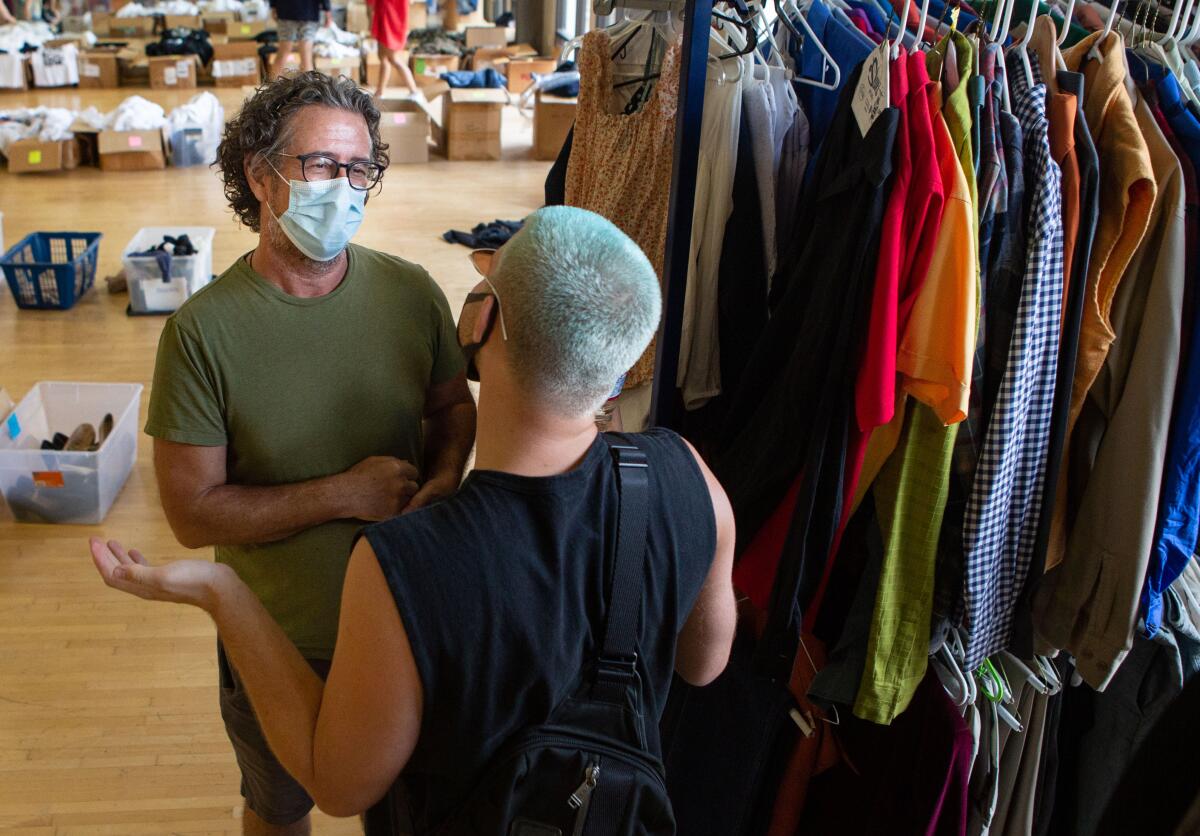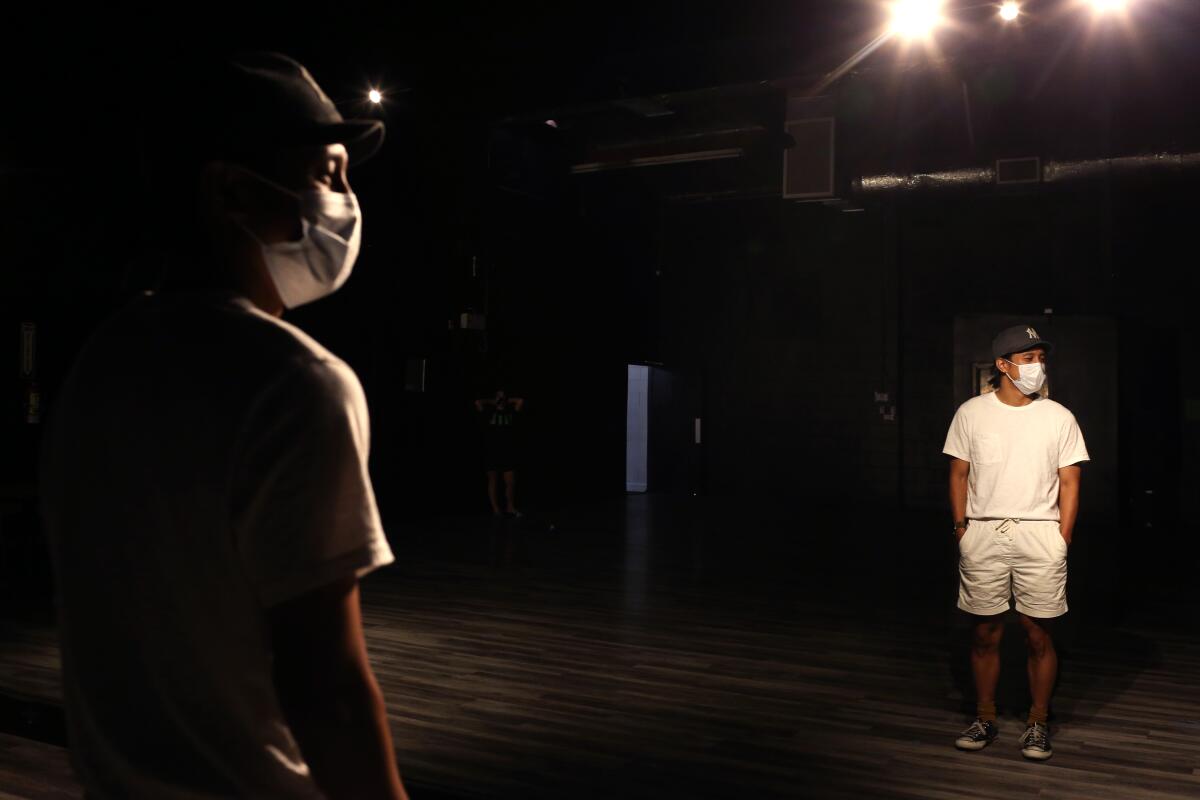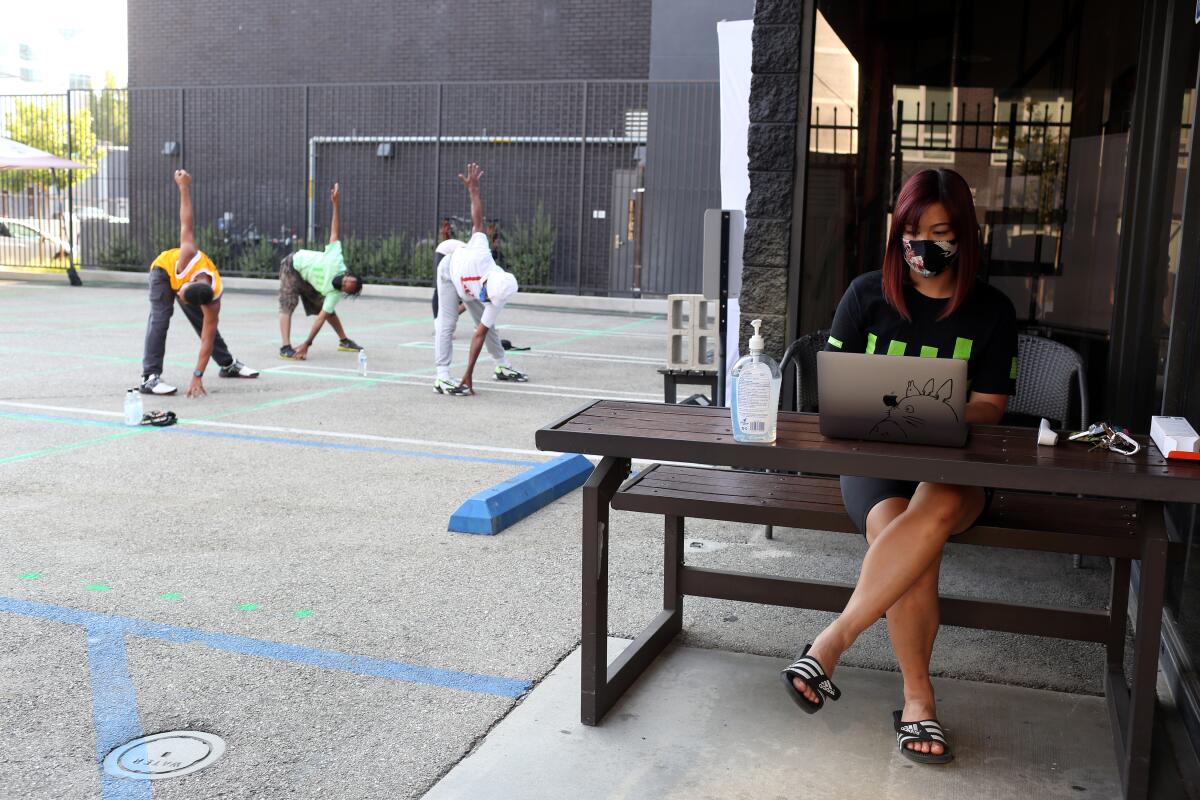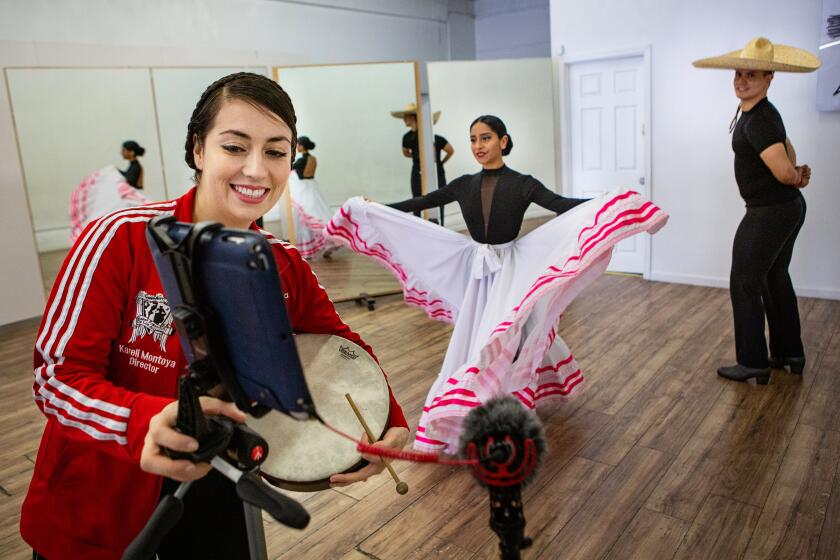L.A.’s dance crisis: Studios fight to survive the pandemic

- Share via
The announcements coming from L.A. dance studios feel eerily similar.
In June, an Instagram post from Pieter Performance Space in Lincoln Heights began: “It is with a heavy heart we share news of the departure from our studio home.”
In a July email to supporters of his Silver Lake studio, Ryan Heffington — the choreographer behind Netflix’s “The OA” and Sia’s “Chandelier” video — wrote: “Due to the uncertainty of our lives, both currently and for the foreseeable future, I’ve decided to take the Sweat Spot entity virtual.”
In August, after the announced sale of Hollywood’s Television Center, Edge Performing Arts Center cofounders Bill Prudich and Randall Allaire posted on Instagram: “We have just been informed that Edge will not be part of the building’s future development. … Their plans, combined with the hardship created by the COVID-19 mandatory closures have resulted in this outcome.”
The flurry of goodbye-for-now messages, combined with desperate pleas for support across social media and GoFundMe, paint a picture of a dance landscape in crisis. Without dance studios, professionals lose their places to train or work out new art before it appears to the masses. And amateurs lose their go-to outlet for creative expression or alternative to boring workouts.
Mandatory coronavirus-related closures have wiped out most income for dance studios, which rely on in-person classes, rentals and performances. And although many studios have shifted to online learning, it may not generate enough income to last through the uncertain months ahead.
Even before the pandemic, running a dance studio in L.A. was notoriously challenging.
For a room full of teenage tap dancers, the studio at Dance Arts Academy was surprisingly quiet.
Many studios struggled to stay afloat amid real estate development and rising rents across the city. Last year, several dance spaces closed, including Dance Arts Academy, which had been in its mid-Wilshire space for 19 years, and the original North Hollywood studio created by the late Debbie Reynolds in 1979.
COVID-19 could accelerate the demise of others.
After learning the building that houses their performing arts center was sold, Prudich and Allaire hosted a clearance sale of portable barres, furniture, and boxes and bins of costumes. Unsure about where they would go after moving out, they opted to sell the items instead of paying for storage.

Founded in 1992, Edge became a training ground for dancers who want to work in film, TV and music. The center has also hosted auditions and rehearsals for Cher, Jennifer Lopez and Madonna.
Although Prudich and Allaire had no control over the building’s sale, the bills were already piling up because of the pandemic.
Edge received a Paycheck Protection Program loan but it didn’t cover rent, Prudich said. Once they leave the space this month, the two will figure out next steps. “I don’t want to cast anybody as the bad guy in this,” Prudich said. “It’s just people doing business.”
They plan to continue virtual classes, “just so we stay in the consciousness of everybody, and then look down the line to reopen — like a phoenix out of the ashes,” Prudich said.
Choreographer Meg Wolfe opened We Live in Space in 2016 after searching for a place to rehearse her work and run a residency program. After finding a storefront with an upstairs apartment for less than $3,000 a month in Jefferson Park, Wolfe renovated the space into a one-room dance studio.
We Live in Space ran with rental money, grant funding and dedicated volunteers who cleaned in exchange for studio time. “Eventually it got to a point where the space was breaking even financially,” Wolfe said via email. “But it was always a tenuous existence. The rent was raised about 5% each year.”
She decided not to renew the lease, which was up at the end of May. “As much as I loved what we were able to do with that space and the energy of the community that grew around it, at a certain point it just would not have been feasible to continue.”
The coronavirus crisis forced dance companies — folklórico, ballet, modern — to find ways to make money and reach audiences. Think screens, not stages.
Other spaces on the brink of closing are fighting to survive the near future.
The summer months are typically bustling for the Movement Lifestyle, a North Hollywood studio that opened in 2012 specializing in hip-hop and other street dance styles. But running the studio during the pandemic has been a roller-coaster experience, co-founders and brothers CJ and Shaun Evaristo said.
They first offered free classes on Instagram Live, but once they started charging for Zoom classes — about half the cost of $15 in-person classes — attendance dropped dramatically. “We had 20 the first week, and then it started to go down to five, maybe three students,” CJ said. “We cut off the online classes because it was too much of a hassle.”
In April, they launched a successful GoFundMe campaign to raise $50,000, which covers one month’s expenses including rent, teacher and staff payroll, and utilities. They made an arrangement with their landlord to defer rent payments for a few months, which they’re now paying back.

“Our finances are just continuing to bleed,” CJ said.
Before the pandemic, the studio offered about 50 classes a week. The most popular would max out at 120 students in the large studio and 45 students in the small studio. Now the studio hosts five to 10 outdoor classes a week, and the average attendance is 15.
“It’s looking really bleak for us, and I don’t know if we’re even talking about what the next steps are for us, if we can continue,” Shaun said.
One staff member suggested another fundraising campaign, CJ added. “But there’s a part of me and Shaun that just feels like it’s not right to do another GoFundMe when so many people are out there in the same situation as us. … If we don’t figure it out — it is what it is.”

L.A. concert dance was blossoming before this year, said Deborah Brockus, a choreographer who runs a space in the Brewery Artist Lofts Complex near downtown. But the triple impact of the real estate market, Assembly Bill 5 — California’s gig-economy law that makes it harder to treat workers as independent contractors — and the pandemic have left her “shattered.”
“Artists are already moving out of town, and they started that pretty quick because there’s no work,” she said of dancers moving to places with a lower cost of living.
Even before the chaos of this year, she was barely breaking even, paying for her space through performances, rentals and grant funding. Now, she can’t pay rent at all.
“My landlord has to evict all of us, which they might do,” she said. “They might just sell the property or they have to work with us.”
One bright spot, Brockus said, was the shift to online learning and performances. That has helped to democratize access to dance and provided another avenue for out-of-work dancers to make money.
Subscription-based online dance platforms that provide a better user experience than shaky Instagram Lives and Zooms are seeing major growth during the pandemic.
In the last five months, the number of users has more than doubled for L.A.-based CLI Studios, a platform with pre-recorded and live-streamed classes from more than 300 instructors and a large production operation, filming about 50 classes a week.
Founder and CEO Jon Arpino emphasized the goal for CLI was to provide supplementary dance education and increase access to dance through technology.
“We always tell people you should do whatever you can locally to train in person,” he said. “Online instruction is not a replacement for in-person instruction.”
From April 2019 to April 2020, the L.A.-based dance platform Steezy Studio, co-founded by Evan Zhou, grew 540% in subscribers. (The platform said it had users in more than 100 countries but declined to elaborate on the number of subscribers.)
After launching its first online class in 2015, Steezy has more than 700 classes focused on street styles. Its sleek user interface allows students to watch videos from different angles and loop sections of choreography while they’re learning.
For studios that are just now adopting online education as a means to keep the business alive, outside financial assistance is crucial.
Dance organizations need money, said Dorothy Dubrule, director of Pieter Performance Space, which went virtual after class, workshop and studio rental income was wiped out.
“Lots of them, including ourselves, are not eligible for some of the CARES Act relief fund, and there haven’t been that many relief funds that dance organizations are eligible for when it comes to specific arts relief money in Los Angeles,” Dubrule said.
Toni Ricci, the owner of Elite Dance and Performing Arts Center in Woodland Hills, said she typically enrolls about 500 students in the fall. This year, she has about 100, who will have the option to take class online, outdoors or inside under COVID-19 restrictions.
But with rent, payroll, utilities and other expenses between $50,000 and $60,000 each month, she’s not sure what the future holds.
“We have a fraction of that coming in,” Ricci said. “I’m getting close to having to make that hard decision if I go bankrupt or not, because there just isn’t money.”
More to Read
The biggest entertainment stories
Get our big stories about Hollywood, film, television, music, arts, culture and more right in your inbox as soon as they publish.
You may occasionally receive promotional content from the Los Angeles Times.













